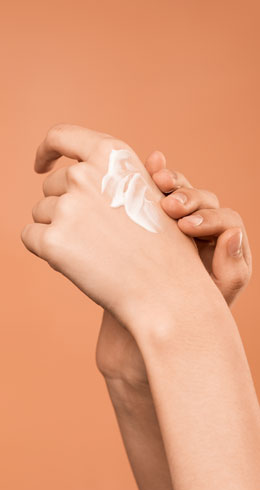Sorbitan Esters
Sorbitanesters and Polysorbates as nonionicoffer many advantages over ionic surfactants including increase stability, enhance flexibility and provide wider compatibility. They are stable in mild acids, alkalis and electrolytes and do not react with ionic ingredients or actives.
Sorbitanesters are nonionic lipophilic surfactants that are commonly used as water-in-oil (W/O) emulsifiers and stabilizers. Sorbitan fatty acid estersare produced by esterification of dehydrated sorbitol (sorbitan) with a variety of fatty acids. Sorbitol is a sugar alcohol that can be obtained by the reduction of glucose or derived from corn, potatoes, etc. The fatty acids commonly used to synthesize sorbitan esters include lauric acid, palmitic acid, stearic acid, and oleic acid.
Sorbitan esters used as non ionic surfactants are effective for various functions. Our range of surfactants is used in a variety of settings, for example, as an emulsifier in food, a stabilizer in a cosmetic cream formulation, or a cosolvent and antirust agent for petroleum and oil. These surfactants are sourced from vegetables and vegan friendly. They are safe and nontoxic as food additives when used according to regulations.
Our range of span sorbitanesters has a hydrophilic-lipophilic balance (HLB) between 1.6 - 8.6, which make them dissolvable in polar organic solvents and oils. When used in combination with varying proportions of ethoxylated sorbitan esters (polysorbate) that have an HLB range between 10.0 – 16.7, it creates more versatile surfactants; which can produce W/O or oil-in-water (O/W) emulsions with varying levels of consistencies, expanding the possible applications of these surfactants.
FAQs of Our Sorbitan Ester
What is the difference between non-ionic and ionic surfactants?
Compare to ionic surfactants, non-ionic surfactants are less sensitive to acidity or alkalinity.
What is a water-in-oil (W/O) emulsifier?
In water-in-oil emulsion, the hydrophilic parts of emulsifiers surround the water droplets and expose their lipophilic portions to the oil phase. This allows water droplets to suspend in oil environment.
What is sorbitan ester made of?
Sorbitan ester is composed of sorbitol-derived hexitol anhydrides aka sorbitans and various fatty acids (lauric acid, palmitic acid, stearic acid, and oleic acid, etc.). Polyoxyethylene sorbitan fatty acid esteris attached to sorbitans through esterification reactions.
Is sorbitol the same as sorbitan?
Sorbitol is a sugar alcohol (crystalline hexahydric alcohol) that can be sourced from plants, such as corns and potatoes. When sorbitol undergoes a dehydration process, where one water molecule is removed, it creates an anhydride called sorbitan.
What is HLB value?
HLB value is the abbreviation for hydrophilic-lipophilic balance, it is the ratio between the hydrophilic portions and lipophilic portion of a surfactant. It is represented by a number between 1 and 20. An HLB value less than 6 indicates that the surfactant favors W/O emulsion; an HLB value greater than 8 favors O/W emulsion. HLB values in between 7 and 9 indicate that the surfactants are good wetting agents.
Is sorbitan ester safe?
Sorbitan esters are widely used in cosmetics, food, medicines. They are generally considered as non-toxic and non-irritant. They are considered to be safe cosmetic ingredients.2 According to the World Health Organization (WHO), sorbitan esters composed of lauric acid, palmitic acid, oleic acid and stearic acid are safe to consume as food additives.1 The group ADI value of these sorbitan esters is 0-25mg/kg body weight/ day.1 Acute and long-term studies have shown that sorbitan esters are non-toxic via ingestion.2 During digestion, sorbitan esters are hydrolyzed into sorbitan and fatty acid; the fatty acid moiety is absorbed and metabolized, whereas the sorbitan moiety is excreted through urine, feces or respiration.
在线联系供应商
Other supplier products
| Sorbitan Monolaurate | What Is Sorbitan Laurate? Sorbitan monolaurate, also known as sorbitan laurate/SML, is synthesized by the esterification of sorbitan with lauric a... | |
| Sorbitan Monooleate | Sorbitan monooleate, also known as sorbitan oleate/SMO, is synthesized by the esterification of sorbitan with oleic acid. It has a molecular form... | |
| Polysorbate 60 | Polysorbate 60, also known as polyoxyethylene sorbitan monostearate, consists of sorbitol, ethylene oxide, and stearic acid. The molecular formula ... | |
| Polysorbate 81 | Polysorbate81, also known as polyoxyethylene (5) sorbitan monooleate, consists of sorbitol, ethylene oxide, and oleic acid. It has a molecular form... | |
| Polysorbate 20 | Polysorbate 20, also known as polyoxyethylene (20) sorbitan monolaurate. It consists of sorbitol, ethylene oxide, and lauric acid. It has a molecul... |
Same products
| MOBILUX EP 0 16KG Lithium Complex Grease | 卖方: 广东聚广恒自动化设备有限公司 | Mobilux EP 0grease is a brown lithium complex grease that provides good low temperature pumpabili... | |
| Nisin | 卖方: Hebei Shengxue Dacheng Pharmaceutical Co., Ltd. | Nisin, a natural antimicrobial peptide, has various applications in the food industry due to its ... | |
| Nisin | 卖方: Hebei Shengxue Dacheng Pharmaceutical Co., Ltd. | Nisin is considered a natural preservative because it is derived from the fermentation of bacteri... | |
| Nisin | 卖方: Hebei Shengxue Dacheng Pharmaceutical Co., Ltd. | Nisin is a natural antimicrobial peptide produced by certain strains of the bacterium Lactococcus... | |
| Nisin Quality Manufacturer | 卖方: Hebei Shengxue Dacheng Pharmaceutical Co., Ltd. | In some cases, the addition of nisin allows dairy products to be preserved without the need for e... |





















